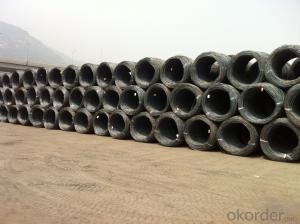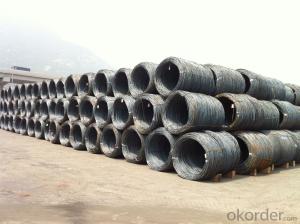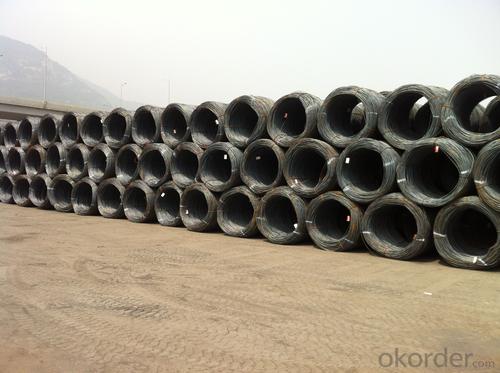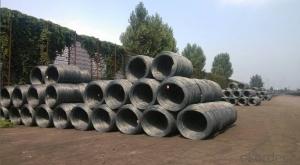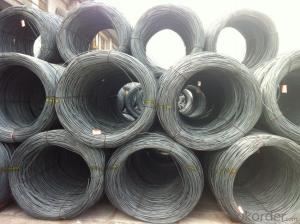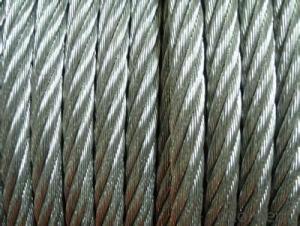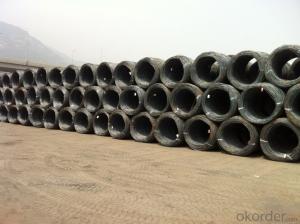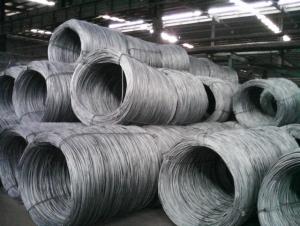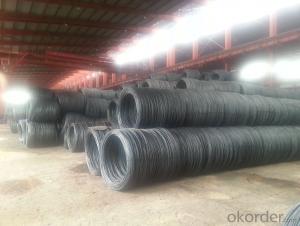Hot Rolled Wire Rods With High Quality and Best Price
- Loading Port:
- Tianjin
- Payment Terms:
- TT OR LC
- Min Order Qty:
- 25 m.t
- Supply Capability:
- 20000 m.t/month
OKorder Service Pledge
OKorder Financial Service
You Might Also Like
Specification
OKorder is offering Hot Rolled Carbon Steel Wire Rod 5.5mm with High Quality at great prices with worldwide shipping. Our supplier is a world-class manufacturer of steel, with our products utilized the world over. OKorder annually supplies products to European, North American and Asian markets. We provide quotations within 24 hours of receiving an inquiry and guarantee competitive prices.
Product Applications:
Hot Rolled Carbon Steel Wire Rod 5.5mm with High Quality is widely used in construction and manufacturing. Carbon steel wire rod is mainly used for reinforcement of reinforced concrete and welded structure or reprocessed (roberts , nail, etc.) materials, especially used to produce wire drawing, welding electrode, nails, spring, electronic, precise machinery parts and so on.
Product Advantages:
OKorder's Hot Rolled Carbon Steel Wire Rod 5.5mm with High Quality are durable, strong.packed and suitable for wire mesh,nail manufacture and construction
Main Product Features:
· Premium quality
· Prompt delivery & seaworthy packing (30 days after receiving deposit)
· Can be recycled and reused
· Mill test certification
· Professional Service
· Competitive pricing
Product Specifications:
Manufacture: Hot rolled
Grade: SAE1006 SAE1008 SAE1010 SAE1012 SAE1016 SAE1018
Certificates: ISO, SGS, BV, CIQ
Weight per Coil:2-2.05tons
Packaging: Export packing, packed by coil
Grade | Chemical Composition (%) | |||||
C | Mn | S | P | Si | B | |
SAE1006B | 0.03~O.07 | 0.32max | 0.045max | 0.040max | 0.30max | 0.0008min |
Mechanical properties | ||||||
Yield strength(N/mm2) | Tensile strength(N/mm2) | Elongation (%) | ||||
250-280 | 350-380 | ≥32 | ||||
Grade | Chemical Composition (%) | |||||
C | Mn | S | P | Si | B | |
SAE1008B | 0.10max | 0.3~0.50 | 0.050max | 0.040 max | 0.15max | 0.0008 min |
Mechanical properties | ||||||
Yield strength(N/mm2) | Tensile strength(N/mm2) | Elongation (%) | ||||
≥195 | 315-430 | ≥30 | ||||
FAQ:
Q1: Why buy Materials & Equipment from OKorder.com?
A1: All products offered byOKorder.com are carefully selected from China's most reliable manufacturing enterprises. Through its ISO certifications, OKorder.com adheres to the highest standards and a commitment to supply chain safety and customer satisfaction.
Q2: How do we guarantee the quality of our products?
A2: We have established an advanced quality management system which conducts strict quality tests at every step, from raw materials to the final product. At the same time, we provide extensive follow-up service assurances as required.
Q3: How soon we can delivery the goods ?
A3: We have a mill with 20000mts of capacity per month. We can delivery the goods within in one month ,as long as your order quantity less than 20000mts.
Q4: How many tons can be loaded into one 20ft container?
A4: Around 18—20tons,9-10 coils.
Image:
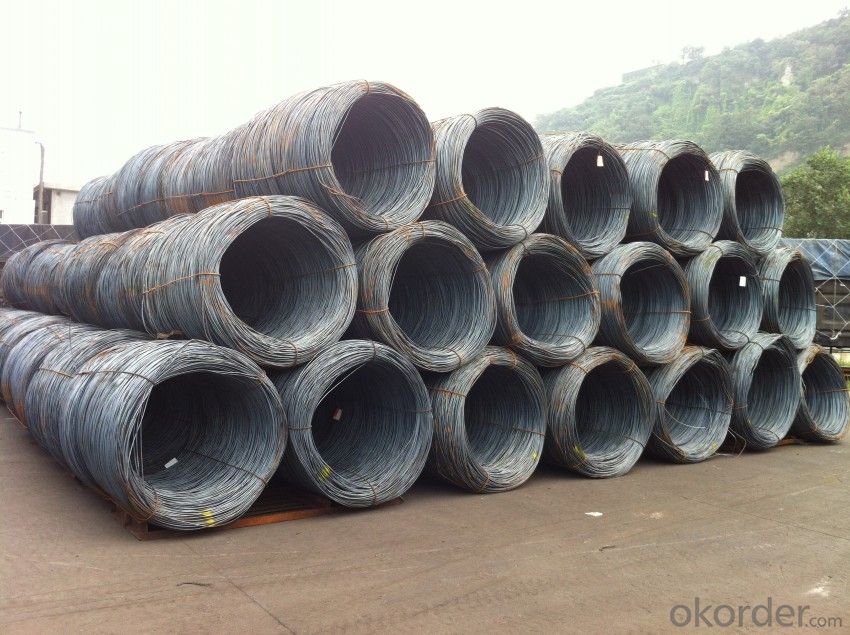
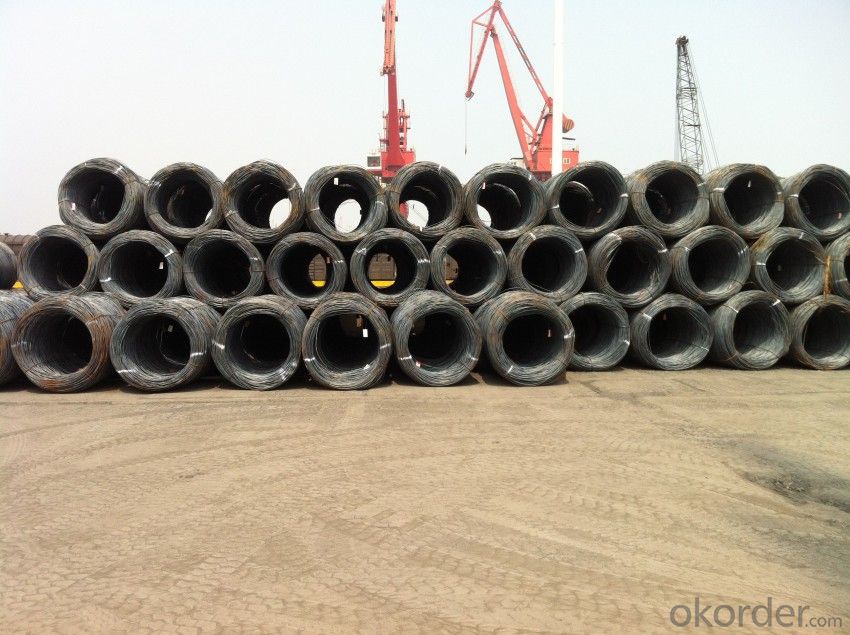
- Q: What are the common industry skills for steel wire rod suppliers?
- Some common industry skills for steel wire rod suppliers include knowledge of steel manufacturing processes, understanding of quality control and inspection procedures, expertise in handling and storing steel wire rods, ability to interpret technical specifications, proficiency in inventory management, strong communication and negotiation skills, and familiarity with market trends and customer demands.
- Q: What are the different measurement techniques used for steel wire rod?
- There are several measurement techniques commonly used for steel wire rods. These include diameter measurement using calipers or micrometers, length measurement using a measuring tape or ruler, weight measurement using a weighing scale, and surface inspection using visual inspection or non-destructive testing methods such as ultrasonic or magnetic particle testing. Additionally, mechanical properties such as tensile strength and hardness can be measured using specialized equipment like testing machines or hardness testers.
- Q: How are steel wire rods used in the production of wire cables?
- Steel wire rods are an essential raw material used in the production of wire cables. These rods are typically made from carbon or alloy steel and are formed into long, cylindrical shapes. They are then processed through various stages to transform them into wire cables. The first step in the production process involves hot rolling the steel wire rods. This process involves passing the rods through a series of rollers, which gradually reduce their diameter and increase their length. This hot rolling process helps to improve the ductility and strength of the steel, making it suitable for further processing. After hot rolling, the steel wire rods are then subjected to a process called cold drawing. In this process, the rods are drawn through a series of dies at room temperature, which further reduces their diameter and increases their length. This cold drawing process helps to refine the steel's surface finish and improve its mechanical properties, such as tensile strength and flexibility. Once the desired diameter and length are achieved, the steel wire rods are then used to produce wire cables. The rods are fed into a wire drawing machine where they are pulled through a series of dies to reduce their diameter even further. This drawing process helps to achieve the desired diameter and surface finish of the wire cables. After the wire drawing process, the steel wire rods are typically subjected to a heat treatment process to improve their mechanical properties. This process involves heating the rods to a specific temperature and then rapidly cooling them to achieve the desired hardness and strength. The final step in the production of wire cables involves stranding the steel wires together to form a cable. The individual steel wires are typically twisted together in a specific pattern, known as a lay, to provide the cable with the desired strength and flexibility. This stranding process is often followed by a coating or galvanizing process to protect the wire cables from corrosion. Overall, steel wire rods play a crucial role in the production of wire cables. They are transformed through various processes such as hot rolling, cold drawing, wire drawing, heat treatment, and stranding to create cables that are strong, durable, and suitable for a wide range of applications.
- Q: How is steel wire rod used in the manufacturing of nails?
- Steel wire rod is an essential raw material used in the manufacturing of nails. It is first drawn through a series of dies to decrease its diameter and increase its length, resulting in a thinner and longer wire. This wire is then cut into appropriate lengths and fed into a nail-making machine. The machine forms the wire into the shape of a nail, cuts the nail to the desired length, and adds a head or point if necessary. Steel wire rod provides the strength and durability required for nails to hold materials together securely.
- Q: How is steel wire rod used in the manufacturing of barbed wire?
- Steel wire rod is a crucial component in the manufacturing of barbed wire as it serves as the base material for creating the barbs. The steel wire rod is first drawn into thin wires, which are then twisted and shaped into sharp points or barbs. These barbs are then attached to a central wire, forming the characteristic barbed wire structure. This process ensures that barbed wire is strong, durable, and effective for various applications such as security fencing, livestock containment, and military purposes.
- Q: How is steel wire rod used in the production of wire shelves?
- Steel wire rod is used in the production of wire shelves as the main material. It is shaped and welded to create the frame and structure of the shelf, providing strength and stability. The wire rods are also used to create the horizontal and vertical wires that form the shelving surface, allowing for the storage and organization of various items.
- Q: What are the major challenges in marketing steel wire rod products?
- There are several major challenges in marketing steel wire rod products. Firstly, the steel industry is highly competitive, and there are numerous suppliers of steel wire rod products in the market. This makes it challenging for companies to differentiate their products and stand out from the competition. Marketing efforts must focus on highlighting the unique features, quality, and value proposition of the steel wire rod products to attract customers. Secondly, the steel industry is heavily influenced by economic factors and global market conditions. Fluctuations in steel prices, changes in demand, and trade policies can significantly impact the market for steel wire rod products. Companies need to closely monitor these factors and adjust their marketing strategies accordingly to remain competitive and profitable. Thirdly, steel wire rod products are often used as raw materials in various industries such as construction, automotive, and manufacturing. This means that the demand for steel wire rod products is closely tied to the performance of these industries. Market fluctuations and changes in these industries can pose challenges in terms of demand forecasting and market positioning for companies marketing steel wire rod products. Additionally, steel wire rod products may require customization or specific certifications to meet the requirements of different industries or projects. This can add complexity to the marketing process as companies need to understand the specific needs and regulations of their target customers and adapt their marketing strategies accordingly. Moreover, environmental concerns and sustainability are gaining more attention in the steel industry. Companies marketing steel wire rod products need to address these concerns by promoting environmentally friendly production processes, sustainable sourcing of raw materials, and recycling initiatives. Failure to address these issues can result in reputational damage and loss of customers. Lastly, building and maintaining strong relationships with customers is crucial in the steel industry. This requires continuous communication, after-sales support, and the ability to provide technical assistance when needed. Developing and maintaining these relationships can be challenging, especially when dealing with large and diverse customer bases. In conclusion, the major challenges in marketing steel wire rod products include intense competition, economic factors, fluctuations in demand, customization requirements, environmental concerns, and the need for strong customer relationships. Overcoming these challenges requires strategic planning, market intelligence, and continuous adaptation to the changing market dynamics.
- Q: What are the main factors influencing the choice of steel wire rod packaging?
- The main factors influencing the choice of steel wire rod packaging include the requirements for protection, transportation, handling, and storage of the product. One of the key factors is the need for protection. Steel wire rods are prone to damage from various external factors such as moisture, dirt, and corrosion. Therefore, the packaging must provide adequate protection against these elements to ensure the quality and integrity of the product. This may involve using materials that are moisture-resistant, such as plastic or coated paper, and implementing measures to prevent rust and corrosion, such as applying anti-corrosion coatings. Transportation considerations also play a crucial role in determining the packaging choice. Steel wire rods are often transported over long distances, either by road, rail, or sea. The packaging should be sturdy enough to withstand the rigors of transportation, including potential impacts and vibrations. It should also be designed in a way that facilitates easy loading and unloading, and minimizes the risk of damage during handling and transportation. The storage requirements of steel wire rods also influence the packaging choice. Depending on the storage conditions, such as indoor or outdoor storage, the packaging may need to offer additional protection against factors like sunlight, extreme temperatures, and humidity. It should also be stackable to optimize space utilization and prevent any deformation or bending of the wire rods. Other factors that may influence the choice of steel wire rod packaging include cost-effectiveness, sustainability, and regulatory compliance. Companies may consider the cost of the packaging material, its availability, and the overall packaging process to ensure that it aligns with their budget and operational efficiency. Moreover, there is an increasing focus on sustainable packaging solutions that minimize environmental impact, such as using recyclable materials or reducing the overall packaging waste. Compliance with industry standards and regulations, such as safety and labeling requirements, is also a significant consideration in the choice of steel wire rod packaging.
- Q: What are the factors that affect the tensile strength of steel wire rod?
- The tensile strength of steel wire rod can be affected by various factors. These factors include: 1. The chemical composition of the steel, such as carbon, manganese, and silicon. The specific combination of elements can have a significant impact on the tensile strength. Higher carbon content generally increases strength, while other alloying elements can enhance or reduce strength based on their properties. 2. The heat treatment process, which involves heating and cooling the steel wire rod. This process can alter the microstructure of the steel and ultimately affect its tensile strength. Different methods, like quenching and tempering, can be used to achieve the desired strength level. 3. The manufacturing process of the steel wire rod. The way the rod is produced and processed can influence its tensile strength. Factors like rolling temperature, reduction ratio, and cooling rate can affect the alignment of the steel's crystalline structure, which in turn affects its strength properties. 4. The grain size of the steel wire rod. The size of the grains in the steel can impact its tensile strength. Smaller grain sizes generally result in higher strength, as they provide more barriers for dislocations to move through the material. 5. The surface condition of the steel wire rod. The presence of surface defects, such as cracks or scratches, can weaken the tensile strength. Therefore, proper surface treatment and handling during manufacturing and transportation are crucial for maintaining its strength. 6. The environmental conditions in which the steel wire rod is used. Factors like temperature, humidity, and exposure to corrosive substances can degrade or embrittle the material, leading to reduced strength. In conclusion, the tensile strength of steel wire rod is influenced by its chemical composition, heat treatment, manufacturing process, grain size, surface condition, and environmental factors. It is important to understand and control these factors to ensure the desired strength and performance of the steel wire rod in different applications.
- Q: How is the wear resistance of steel wire rod assessed?
- Assessing the wear resistance of steel wire rod can be done using various methods. One commonly used approach involves conducting the pin-on-disk test. In this test, a steel pin is pressed against a rotating disk made of a different material. The amount of wear experienced by the steel pin is then determined by measuring the weight loss or volume loss after a certain number of rotations. Another method, known as the abrasion test, entails rubbing the steel wire rod against a rough surface and measuring the resulting wear. Furthermore, evaluating the wear resistance of the steel wire rod can also be achieved by subjecting it to realistic conditions, such as within a machine or equipment, and observing its performance over time. These methods serve to gauge the steel wire rod's ability to endure wear and offer invaluable insights for the development and enhancement of products.
Send your message to us
Hot Rolled Wire Rods With High Quality and Best Price
- Loading Port:
- Tianjin
- Payment Terms:
- TT OR LC
- Min Order Qty:
- 25 m.t
- Supply Capability:
- 20000 m.t/month
OKorder Service Pledge
OKorder Financial Service
Similar products
Hot products
Hot Searches
Related keywords
